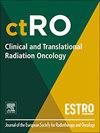CD8-positive lymphocyte infiltration as a marker of anti-tumor immune response in rectal cancer: pre- and post-neoadjuvant radiotherapy comparison
IF 2.7
3区 医学
Q3 ONCOLOGY
引用次数: 0
Abstract
Background
Antitumor immunity, exerted by CD8+ cytotoxic T lymphocytes, plays a vital role in tumor control. Therefore, the present study was conducted to compare the amount of CD8+ tumor-infiltrating lymphocytes (TILs) before and after either long- (LCRT) or short-course radiotherapy (SCRT) in rectal cancer.
Methods
This study retrospectively assessed rectal cancer patients treated by neoadjuvant radiotherapy between 2019 and 2021. Biopsy and surgical samples were subjected to immunohistochemical staining to count CD8+ TILs. The association between the post-to-pre-treatment CD8+ count ratio and treatment groups, histopathological factors, and response to treatment was assessed.
Results
A total of 34 patients were included, with 23 (67.6 %) receiving LCRT and 11 (32.4 %) receiving SCRT. The mean age was 58.56 ± 13.59 years. The number and percentage of CD8+ TILs increased significantly after radiotherapy in all patients (P < 0.001). An increase in CD8+ TILs was observed in both groups, with LCRT showing a median post-to-pre-treatment count ratio of 2.77 and SCRT showing 3.1 (P = 0.127). A generalized linear multivariate model adjusting for mucinous histology, surgical grade, and pathological stages revealed that SCRT was associated with a significantly higher post-to-pre-treatment CD8+ count ratio compared to LCRT (P = 0.03).
Conclusion
Our study highlights that both SCRT and LCRT significantly increase CD8+ TIL count and percentage, reflecting robust immune activation after radiotherapy in rectal cancer, with SCRT showing a higher relative increase, though not statistically significant in unadjusted analyses. After adjusting for histopathological variables, SCRT was independently associated with a greater increase in CD8+ T cells.
cd8阳性淋巴细胞浸润作为直肠癌抗肿瘤免疫反应的标志物:新辅助放疗前后的比较
CD8+细胞毒性T淋巴细胞的抗肿瘤免疫在肿瘤控制中起着至关重要的作用。因此,本研究旨在比较直肠癌长期放疗(LCRT)和短期放疗(SCRT)前后CD8+肿瘤浸润淋巴细胞(TILs)的数量。方法回顾性分析2019 ~ 2021年接受新辅助放疗的直肠癌患者。活检和手术标本经免疫组化染色计数CD8+ TILs。评估治疗前后CD8+计数比与治疗组、组织病理因素和治疗反应之间的关系。结果共纳入34例患者,其中LCRT 23例(67.6%),SCRT 11例(32.4%)。平均年龄58.56±13.59岁。所有患者放疗后CD8+ TILs的数量和百分比均显著增加(P <;0.001)。两组患者CD8+ TILs均升高,LCRT治疗后与治疗前计数比中位数为2.77,SCRT治疗后与治疗前计数比中位数为3.1 (P = 0.127)。调整黏液组织学、手术分级和病理分期的广义线性多变量模型显示,与LCRT相比,SCRT与治疗前后CD8+计数比显著升高(P = 0.03)。我们的研究强调,SCRT和LCRT均显著增加了直肠癌放疗后CD8+ TIL计数和百分比,反映了强大的免疫激活,SCRT的相对增加更高,但在未经调整的分析中无统计学意义。在调整组织病理学变量后,SCRT与CD8+ T细胞的增加独立相关。
本文章由计算机程序翻译,如有差异,请以英文原文为准。
求助全文
约1分钟内获得全文
求助全文
来源期刊

Clinical and Translational Radiation Oncology
Medicine-Radiology, Nuclear Medicine and Imaging
CiteScore
5.30
自引率
3.20%
发文量
114
审稿时长
40 days
 求助内容:
求助内容: 应助结果提醒方式:
应助结果提醒方式:


